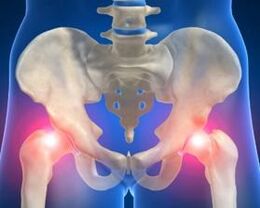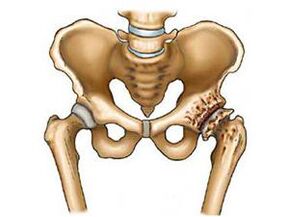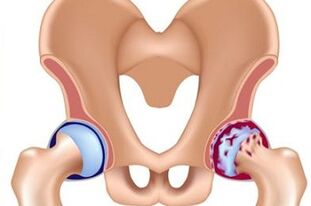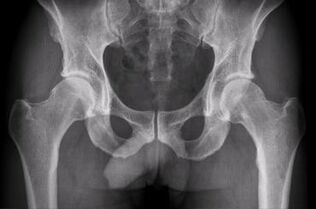
Osteoarthritis of the hip joint (coxarthrosis) is a chronic, gradually progressive disease, in the absence of timely and correct treatment, it can provoke complete loss of movement in it. The end indicates that an inflammatory process does not prevail, but a degenerative one.
The symptoms of this disease vary according to the stage. At first, this is a barely noticeable discomfort that occurs when walking and exercising. Perhaps manifestation in the form of mild pain in the thigh area, which disappears at rest. In this case, pain can be felt not only in the thigh, but also in the groin or knee.
As a rule, coxarthrosis is a process that has been going on for many years, characterized by a gradual change in the cartilage resulting in deformation of the bones and loss of joint function. It mainly affects people after 40, but there are also very young patients.
Causes of occurrence
Why does osteoarthritis of the hip joint occur and what is it? The causes of coxarthrosis can be different, but the picture of the disease is always the same. It all starts with a change in the joint cartilage, which becomes thinner and loses its ability to absorb loads. The body compensates for the layering of cartilage tissue by the formation of bone growths along the edge of the joint surfaces, which leads to deformation of the joints and bones of varying degrees.
The main causes of this joint disease:
- Lesions. This may not be a major injury, but in many cases the development of the disease is influenced by chronic microtrauma that contribute to the breakdown and thinning of cartilage. They also affect the laceration of the joint capsule, leading to the accumulation of many injuries. Often, repetitive microtrauma is a harbinger of the appearance of such a disease.
- Excessive loads, leading to systemic microtrauma and joint injuries. Most often it occurs in people who are involved in hard physical work or in professional athletes. In this case, even treatment without lifestyle changes or exercise limitation is ineffective and often accompanied by relapses.
- Hereditary predisposition. These include anomalies in the development of the femoral head itself, underdevelopment of the elements of the joint, and so on. In this case, the so-called dysplastic osteoarthritis of the hip joint occurs.
- Diseases. For example, arthritis, if not treated properly, can turn into osteoarthritis over time. This is due to the fact that during arthritis, the properties of the cartilage tissue change and blood circulation is impaired. This gradually leads to the development of a degenerative process.
- Overweight. Excess body weight, even when walking, exerts a load on the joints that exceeds the physiological limits of strength.
Depending on the cause of the disease and its pathogenesis, there are 2 main types of hip joint osteoarthritis.

- Primary coxarthrosis. In this case, the disease develops very slowly and begins with a violation of the blood supply to the tissues. The reasons for the development of this type of osteoarthritis are rooted in metabolic disorders, which are more common in people over the age of 50. Primary osteoarthritis of the hip joint is the most commonly diagnosed.
- Secondary coxarthrosis. In this case, the disease develops against the background of systemic inflammatory lesions of many joints of the body. Inflammation can be both infectious and autoimmune in nature.
In the initial stage of coxarthrosis, patients are concerned only with mild pain or discomfort in the joint area. Often these signs are ignored, with the result that the disease progresses.
Symptoms of osteoarthritis of the hip joint
Coxarthrosis of the hip joint, the symptoms of which cannot be ignored, can lead to serious consequences. There are several main signs of the disease, which depend on the stage of the disease:
- Pain in the joint area is the most obvious symptom with which any hip disease can be assumed. The intensity and nature of the sensations usually depend on the stage.
- Limitation of limb mobility is also a symptom of coxarthrosis. The initial phase is characterized by a feeling of "stiffness" in the joint, which passes after a certain load.
- Weakening of the thigh muscles can be observed as early as the second stage of the disease, reaching the third stage to complete atrophy.
- Changes in leg length due to pelvic deformity are characteristic of "advanced" osteoarthritis.
- Lameness or change in gait is a very likely sign of bone deformity.
- A sharp crunch of the joint is not always a sign of osteoarthritis. Usually considered when other symptoms are present.
The main symptom of coxarthrosis is pain, the nature of which, its duration, location and intensity depend on the stage of the disease.
Osteoarthritis of the hip joint of 1 degree
This stage of the disease is characterized by pain in the joints and hip, sometimes in the knee, which occurs after physical exertion and subsides after rest. Joint mobility is not limited and there are no gait disturbances.
1st degree coxarthrosis is the initial stage of the disease, starting the treatment of which it is still possible to stop the process of destruction and deformation of the joint and fully preserve its functions. But sadly, many find it unnecessary to see a doctor due to mild joint pain as the disease progresses in the meantime.
2nd degree hip joint osteoarthritis

It manifests itself more clearly: the intensity of pain increases, it occurs not only after exercise, but also at rest, there is a limitation of motor functions. In particular, coxarthrosis is characterized by difficulty in pronation (internal rotation of the hip) and abduction and a contracture is formed.
Radiographic examination shows a narrowing of the joint space and the appearance of bony growths on the surfaces. The acetabulum and the femoral head are deformed. The thigh muscles begin to atrophy on the affected side and the pain syndrome spreads further down, covering both the knee joint and the groin area (it is important to understand that this will not be accompanied by degenerative changes in the jointknee).
Grade 3 osteoarthritis of the hip
The signs of the disease are evident and permanent. Pain syndrome reaches the night. When walking, the patient uses the support. The muscles of the lower leg and thigh gradually atrophy, and the diseased leg of a sick person becomes much shorter.
Often, at the 3rd degree, the joint space disappears completely and the joints grow together into a single bone structure, this is demonstrated by photography. As a result, complete immobility of the joint occurs.
Radiographs show extensive bony growths from the roof of the acetabulum and the femoral head, a sharp narrowing of the joint space. The neck of the femur is significantly widened and shortened.
Diagnostics
Before understanding how to treat osteoarthritis of the hip joint, it is necessary to make a correct diagnosis. If coxarthrosis is suspected, a person will be sent for a biochemical blood test - in the presence of a disease, patients have a slight increase in ESR, globulins, immunoglobulins and seromukoids.
The next step in detecting osteoarthritis is an X-ray photo. It will reveal:
- ossification of cartilage,
- bony growths at the edge of the cartilage,
- by narrowing the distance between the joints,
- thickening of the bone tissue under the cartilage.
Unfortunately, the radiographic photo does not allow to see the joint capsule and the cartilage itself, if it is necessary to obtain information on these soft tissues, the patient will be referred for tomography.
Treatment of osteoarthritis of the hip joint
When osteoarthritis of the hip joint is diagnosed, treatment will directly depend on the stage of the disease. The general treatment regimen provides for the achievement of the following objectives:
- eliminates pain and discomfort in the aching joint area;
- to establish intra-articular cartilage nutrition and start the restoration process;
- eliminates the lack of intra-articular fluid;
- activates microcirculation in the tissues of the joint;
- eliminates the increased load on the hip joint;
- strengthens the muscles that surround, protect and support the joint;
- to prevent deformities and increase mobility in the hip joint.
All this can be achieved only with the help of an integrated approach, which should include not only drug therapy, but also lifestyle changes in order to eliminate risk factors for coxarthrosis.

- In the third stage of the disease, treatment involves surgery, during which the joint is replaced with an endoprosthesis, while part of the prosthesis is implanted in the femur and part in the pelvic bone. The operation is quite complicated, time consuming and requires a long rehabilitation period.
- With degrees I and II of osteoarthritis of the hip joint, treatment is carried out without surgery. Used: non-steroidal anti-inflammatory drugs, muscle relaxants, chondroprotectors, vasodilators, hormonal steroid drugs, topical drugs - ointments, lotions, compresses.
All these drugs are prescribed exclusively by the attending physician. Some are effective by injecting directly into the affected joint area. Such injections can only be performed by qualified medical personnel. Therefore, self-medication is strictly not recommended.
Non-pharmacological methods
In addition to the use of drugs, doctors also recommend non-drug methods of dealing with the disease. These include the following treatments for this disease:
- physiotherapy;
- massage;
- joint breeding;
- diet.
Physiotherapy for osteoarthritis includes the following treatments:
- magnetic therapy;
- UHF and ultrasound therapy;
- aeroionics and electrotherapy;
- inductothermic;
- light therapy;
- application of laser technology.
All these methods can only be used to improve the blood supply to the joints and relieve spasms.
Drug therapy
Combined treatment of hip arthrosis involves the appointment of the following groups of medicines:

- Non-steroidal anti-inflammatory drugs, all relieve pain, relieve inflammation, but do not restore cartilage tissue.
- Chondroprotector. Nutritional preparations for cartilage. Accelerate his recovery. Important in phase 1. 2 of the treatment of osteoarthritis. At grade 3 of the disease, the cartilage is already destroyed, these drugs will be useless. It takes a long time to take drugs, go through several courses.
- Muscle relaxantseliminate muscle spasms in the area of diseased joints, improve blood supply to tissues.
- Ointments and creams. Healing ointments are ways to alleviate the condition of a sick person, but they do not contribute to complete recovery. Warming ointments work well. They irritate the skin receptors and thus reduce pain. Warming ointments also work to restore increased blood circulation in the tissues and muscles around the affected joint.
- Steroid injections into the joint cavity, injections of these drugs are prescribed to relieve exacerbation of the disease and eliminate severe pain.
- Vasodilators, dilate the vessels in and around the joint cavity, thus improving the supply of nutrients necessary for tissue repair.
There is no need to rely heavily on folk remedies. But some healers recommend lemon, garlic or celery root tincture for joint and bone treatment.
Massage in the treatment of coxarthrosis
In case of deformation of arthrosis of the hip joint, the massage gives good results. Massage for coxarthrosis is a very effective and useful method. It is advisable that the massage be performed by a good specialist and as often as possible.
Its action is aimed at improving blood circulation, strengthening muscles, relieving painful spasms, swelling and muscle tension, as well as increasing diastasis between the joint elements of the joint.
In the absence of a professional masseur, the massage can be done alone. Massage for osteoarthritis can be performed both manually and with the help of various massage devices and even a jet of water (hydrocinesis therapy).
Gymnastics
The treatment of osteoarthritis of the hip joint through physical education consists in achieving two objectives: increasing the mobility of the legs and preventing muscle atrophy. All standard complexes of physical therapy for coxarthrosis also have a general strengthening character and a positive effect on the whole body.
The complex of gymnastic exercises is prescribed by a specialist. The first couple of physical therapy sessions should be supervised by a doctor. It will show you how to perform each movement correctly and will also monitor the correct load on the hip joints.
Diet
Key Tips:
- Give preference to porridge over water.
- Eat enough animal protein: fish (except salty), poultry, beef.
- Eat at least 5 servings of vegetables a day (one serving is 100 grams, can be used as a side dish).
- Dairy products are needed: cottage cheese, yogurt, fermented cooked milk.
- Eliminate alcohol, coffee, strong black tea.
- Eliminate sweet and starchy foods.
- Eat small meals, but often.
The diet will reduce the stress on the hip joints and provide them with everything they need for tissue repair.





























